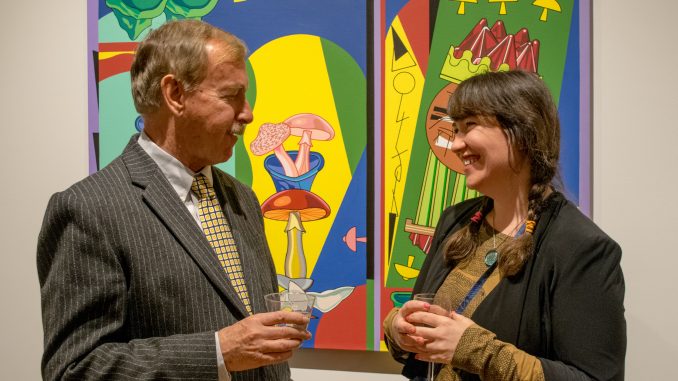
Kate Abercrombie’s technique for making art is simple: she builds off one idea and throws materials together, like ingredients in a mixing bowl.
“I have this idea and I’m mostly interested in the edges of things, where they come together or almost fall apart,” she said.
This method can be seen in the 2000 printmaking alumna’s latest work, “Collage as Painting,” an exhibit on display at the Fleisher/Ollman Gallery on Arch Street near 12th until Jan. 27. In the exhibit, Abercrombie collaborates with New York-based artist Trevor Winkfield.
Abercrombie’s work consists of paintings on paper, while Winkfield’s paintings are on canvas. The finished paintings resemble collages, artwork created by combining different materials like photos and colorful paper.
“You don’t have to just see this as a formal exhibition [with] formal color studies regarding shape and color form,” said Alex Baker, the director of the gallery. “There’s a lot else going on aside from that. That’s where the viewer enters in and works their subjectivity on the artwork on display.”
All of Abercrombie’s paintings were created specifically for the show, while Winkfield selected pieces made during his 50-year career as an artist.
Baker said the idea for the collaboration came after he noticed the similar way Abercrombie and Winkfield use collage as a basis for their paintings.
“When you see the completed work, the way the paintings are made and how they look on the surface of the canvas or the paper, they make themselves known almost as collages,” Baker said. “That’s the underlying formal theme of the show, but then when you look at the work there’s all kinds of meaning that you can grab or analyze from the work on view.”
Abercrombie’s art has been shown in the gallery for almost 10 years, while this is the first time Winkfield’s work has been shown at Fleisher/Ollman.
Abercrombie incorporates imagery she encounters in her daily life into her art, like objects in her home. She uses a combination of tracing, drawing and photocopying images, like magazine and newspaper clippings.
She added that images give her a starting point for her art, but the final piece might end up completely different than how it started.

Similarly, Winkfield makes a collage as his first step toward a painting. He said the collage allows him to identify and correct mistakes before the painting phase because it’s easy to change things around. Once he’s satisfied with his collage, Winkfield traces it onto canvas and fills in the design with acrylics.
Abercrombie said her work is not highly conceptual, but combines formalist painting principles with a starting concept. Her work gives a lot of information to viewers, but doesn’t completely answer the questions they might have, like what a particular element in the painting is or what it represents.
“There’s a lot of clues that there’s things going on, but it doesn’t tell the whole story or reveal a ton,” Abercrombie said. “I think that’s a little bit like me personality-wise. Sometimes the titles are just purely descriptive, but sometimes they give more clues to what the work is about.”
Abercrombie said Winkfield has a more systematic approach.
Winkfield said he has always been very careful in his artwork, like everything else in his life. He said this cautiousness stems from growing up in England during the 1950s when resources were scarce. Items like food, clothing and paper were heavily rationed in the United Kingdom during and after World War II.
“Things were very scarce, so scarce that for being the ‘best boy of the week’ in my class at school I was given a single sheet of typing paper,” Winkfield said. “That was the week’s prize, so it was very valuable. You didn’t put any marks down that you would have to rub out. That’s how I began to paint very carefully.”
Abercrombie said she hopes gallery-goers will take time to reflect on the exhibit because people tend to jump too quickly from one thing to the next. She said she leaves a lot of room for interpretation in her artwork so viewers can ask themselves questions.
“I’m not interested in someone being able to answer every question,” Abercrombie said. “I want someone to be able to see stuff and put a little bit about themselves into it. I think if you slow down, there’s a lot more complexity to the decision making that’s kind of exciting.”



Be the first to comment